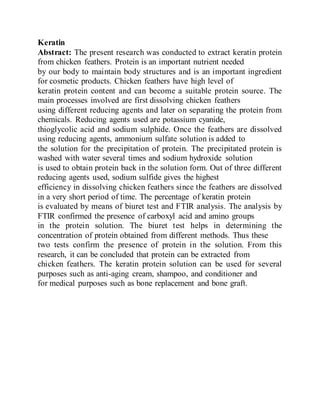Recommended
A high alkaline protease producing bacterial strain was isolated and identified a local soil sample. The organism was gram positive and forms spore during adverse condition in the growth medium. After various tests it was suggested and the features agreed with the description of Bacillus subtilis. It was also identified as B. subtilis with 99.9% identity by API 50 CHB. The enzyme hydrolyses a number of proteins including azocasein which suggests that it is an extracellular alkaline protease. The experimentally determined isoelectric point was 5.1 and the optimal enzyme activity was at 60°C and at pH 8.5. The esterase preferentially hydrolyzed short-chain fatty acids. Native enzyme preparations typically showed a Michaelis constant (Km) and Vmax of 0.40mM and 12,200 U mg)-1, respectively. This microbial enzyme was partially purified by ammonium sulfate fractionation, dialysis, DEAE cellulose chromatography and electrophoretic analysis. Enzyme purity was tested by SDS-PAGE. Quantitative estimation has shown that 40mL of culture supernatant could dehair 2×1 cm of leather completely in 9 hours. In future the tanneries will use a combination of chemical and enzymatic processes. In practical applications, protease is a useful enzyme for promoting the hydrolysis of proteins and showing significant industrial applications.Microbial Production Of Alkaline Proteases And Evaluation Of Its Performances...

Microbial Production Of Alkaline Proteases And Evaluation Of Its Performances...Shafkat Shamim Rahman
Recommended
A high alkaline protease producing bacterial strain was isolated and identified a local soil sample. The organism was gram positive and forms spore during adverse condition in the growth medium. After various tests it was suggested and the features agreed with the description of Bacillus subtilis. It was also identified as B. subtilis with 99.9% identity by API 50 CHB. The enzyme hydrolyses a number of proteins including azocasein which suggests that it is an extracellular alkaline protease. The experimentally determined isoelectric point was 5.1 and the optimal enzyme activity was at 60°C and at pH 8.5. The esterase preferentially hydrolyzed short-chain fatty acids. Native enzyme preparations typically showed a Michaelis constant (Km) and Vmax of 0.40mM and 12,200 U mg)-1, respectively. This microbial enzyme was partially purified by ammonium sulfate fractionation, dialysis, DEAE cellulose chromatography and electrophoretic analysis. Enzyme purity was tested by SDS-PAGE. Quantitative estimation has shown that 40mL of culture supernatant could dehair 2×1 cm of leather completely in 9 hours. In future the tanneries will use a combination of chemical and enzymatic processes. In practical applications, protease is a useful enzyme for promoting the hydrolysis of proteins and showing significant industrial applications.Microbial Production Of Alkaline Proteases And Evaluation Of Its Performances...

Microbial Production Of Alkaline Proteases And Evaluation Of Its Performances...Shafkat Shamim Rahman
More Related Content
Similar to Kera
Similar to Kera (20)
Structure and Role of Enzymes in Steriodogenenic pathways

Structure and Role of Enzymes in Steriodogenenic pathways
Energy-Protein-Consentrate as Product of Glucosamine Extract from Shrimp Wast...

Energy-Protein-Consentrate as Product of Glucosamine Extract from Shrimp Wast...
Processing, composition and sensory properties of chicken breast meat crisps ...

Processing, composition and sensory properties of chicken breast meat crisps ...
AMINO ACID CHANGES IN FERMENTED OYSTER (CRASSOSTREA GIGAS) SAUCE WITH DIFFERE...

AMINO ACID CHANGES IN FERMENTED OYSTER (CRASSOSTREA GIGAS) SAUCE WITH DIFFERE...
10. dr david cadogan feedworks - single cell protein types, benefits and redu...

10. dr david cadogan feedworks - single cell protein types, benefits and redu...
Kera
- 1. Keratin Abstract: The present research was conducted to extract keratin protein from chicken feathers. Protein is an important nutrient needed by our body to maintain body structures and is an important ingredient for cosmetic products. Chicken feathers have high level of keratin protein content and can become a suitable protein source. The main processes involved are first dissolving chicken feathers using different reducing agents and later on separating the protein from chemicals. Reducing agents used are potassium cyanide, thioglycolic acid and sodium sulphide. Once the feathers are dissolved using reducing agents, ammonium sulfate solution is added to the solution for the precipitation of protein. The precipitated protein is washed with water several times and sodium hydroxide solution is used to obtain protein back in the solution form. Out of three different reducing agents used, sodium sulfide gives the highest efficiency in dissolving chicken feathers since the feathers are dissolved in a very short period of time. The percentage of keratin protein is evaluated by means of biuret test and FTIR analysis. The analysis by FTIR confirmed the presence of carboxyl acid and amino groups in the protein solution. The biuret test helps in determining the concentration of protein obtained from different methods. Thus these two tests confirm the presence of protein in the solution. From this research, it can be concluded that protein can be extracted from chicken feathers. The keratin protein solution can be used for several purposes such as anti-aging cream, shampoo, and conditioner and for medical purposes such as bone replacement and bone graft.
